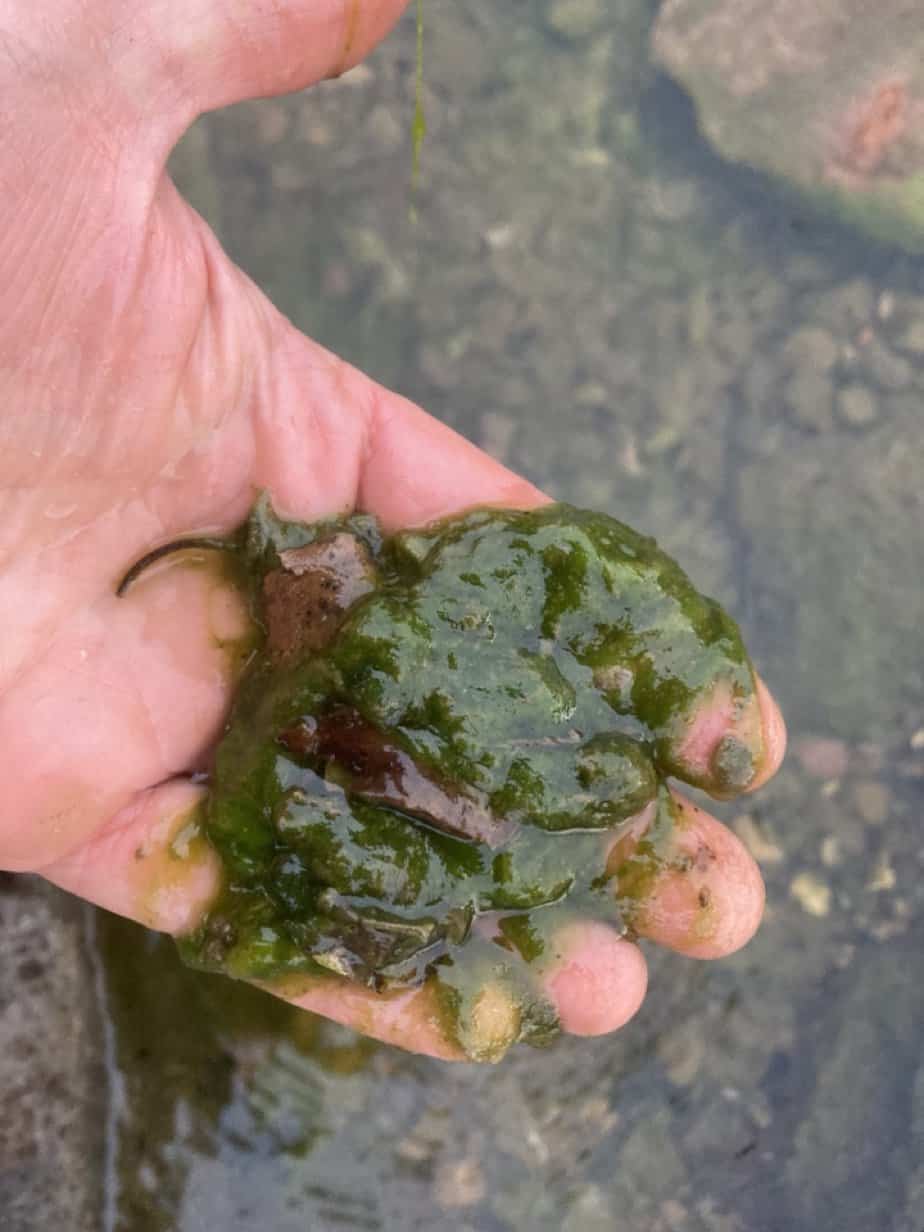Over the years, I’ve faced my fair share of algae battles in ponds, and in this blog post, I want to share some effective ways I’ve used to treat algae problems and prevent their recurrence. As they say, prevention is better than cure.
Algae Prevention
Algae needs two main ingredients to thrive: Nutrients and sunlight. Removing one, or both will help you in your algae battle.
Sunlight can be taken out of the equation by shading the pond, that could be adding more larger plants and trees around the pond. You might also like to add a structure or shade sail to shade the pond.
I have many ponds in full sun and I find that the best way to reduce algae is to reduce the nutrient load inside the pond. To do that I utilise bacteria, plants, low fish loads and I try to avoid adding nutrients. So let’s a look at how that works.
Bacteria
Beneficial bacteria will convert nutrients, particularly nitrogen and phosphate, into less harmful forms, thus reducing the availability of these nutrients to algae.
Bacteria are also skilled at processing nutrients that accumulate in the pond due to: decaying organic material, fish waste, and excess nutrients from various sources (such as water runoff).
When nutrients are present in high concentrations, they can act as a food source for algae, leading to rapid algae growth and bloom.
Bacteria need oxygen and wet surface area to grow on. If we provide ample oxygen and wet surface area the beneficial bacteria will help us process nutrients.
I like to add rock and pebble to my ponds and I also love bog filters, both greatly increase the amount of surface area available to bacteria.
Below is a video I made talking about the benefits of adding a bog filter to a pond.
Plants
Plants play can play an important role in maintaining a healthy pond ecosystem and can help prevent algae growth. They serve as natural shade for the pond, reducing the amount of direct sunlight that reaches the water’s surface.
Also, they uptake nutrients from the water, depriving algae of their food source and inhibiting their growth. However, it’s essential to strike a balance with plant coverage in the pond.
While plants can be beneficial in controlling algae, they can also trap sediments that carry nutrients. If not managed properly, this can lead to an increase in nutrient levels, promoting more plant and algae growth.
Excessive plant growth should be trimmed and removed regularly to prevent nutrient buildup. Proper maintenance ensures that the pond remains in balance and prevents algae from taking over.
Below is a video I made looking at the role that plants play in water filtration.
Fish load
Fish loads in a pond have a direct relationship with nutrient levels, particularly nitrogen. Fish produce waste, which contains nutrients. When there are more fish in the pond, there is more waste, leading to higher nutrient levels in the water.
Excessive nutrients in the pond can fuel algae growth, resulting in unsightly algae blooms. To prevent this, it’s crucial to maintain a balanced fish population.
When fish populations are well-managed, they will naturally forage for food in the pond, consuming insects, small organisms, and even algae. This helps keep nutrient levels in check, reducing the risk of algae outbreaks.
If fish breed, the pond’s carrying capacity may be exceeded, leading to elevated nutrient levels. To maintain a healthy pond ecosystem, it’s essential to consider re-homing or selling some of the young fish to maintain the balance inside the pond.
Properly managing fish loads ensures a healthier pond environment and minimizes the risk of algae overgrowth, contributing to the overall well-being of the pond.
Below is a video where I explain why I hardly ever feed my fish. Reducing the amount of commercial fish food that goes into the pond will also reduce the nutrient levels.
Preventing nutrients
Things like adding tap water to the pond, water runoff and decaying organic material can also add nutrients. So here’s some of the ways that I try, to prevent them, from becoming an issue.
Tap water
Tap water can have an impact on nutrient levels in a pond, which, in turn, can influence algae growth. Topping up the pond with town water can introduce additional nutrients, particularly phosphate, which is often added by water utilities to prevent lead poisoning.
Unfortunately, phosphate serves as an excellent food source for algae, leading to rapid growth when present in the water. Moreover, tap water might contain other dissolved nutrients and minerals, especially after heavy rain, when organic materials and sediments from the local catchment can wash into the water supply.
These additional nutrients can contribute to algae blooms if not managed properly. Consider the use of water conditioners and phosphate binders to minimise nutrient levels in tap water.
In the long term, collecting and utilising rainwater through a water tank is the most effective strategy to reduce reliance on tap water and mitigate the risk of nutrient-induced algae outbreaks.
Water runoff
Water runoff can also have a significant impact on the nutrient levels in a pond and influence algae growth.
As water moves over land, it picks up various pollutants, including sediments, organic materials, and nutrients. When this water runoff finds its way into the pond, it introduces additional nutrients, which can fuel algae growth.
To prevent excessive nutrient influx from water runoff, it is crucial to control water flow and ensure that runoff water does not enter the pond.
I like to slope the edges of my pond, therefore water from the surrounding landscape is diverted around the pond, not onto the pond.
Here’s a video where I talk about the pond edges.
Reducing the nutrient load
Netting out organic materials and incorporating skimmers or intake bays are effective strategies to reduce the organic load in a pond.
Organic materials, such as leaves, twigs, and other debris, can accumulate in the water and decompose, releasing nutrients that contribute to algae growth. By regularly using a net to remove these organic materials, you can prevent nutrient buildup and maintain water clarity.
Additionally, skimmers or intake bays are essential components in a well-designed filtration system. These devices work to skim the water’s surface, capturing floating debris and preventing them from decaying in the pond.
As a result, fewer nutrients are released into the water, creating a healthier environment that discourages excessive algae growth. Implementing these practices helps to strike a balance in the pond ecosystem, keeping nutrient levels in check and reducing the risk of algae outbreaks.
Below are a couple of videos: In one I talk about netting the pond, thus removing leaves, etc.
In the other I talk about skimmers, intake bays and negative edges, all create skimming action on the waters surface, helping prevent leaves sinking to the bottom of the pond.
Algae treatments
While prevention is better than cure, sometimes you need a cure as you work on the prevention. Below I’ll discuss some of the various option that are available. I’ll start with the least harmful, then move towards the more nuclear solutions.
Diatoms
Diatoms are beneficial microorganisms (they are kinda part plant, part algae) that can outcompete and control the growth of problematic algae.
Unlike traditional plants, diatoms have the unique ability to respond quickly to changes in nutrient levels. When there is a sudden spike in available nutrients, diatoms rapidly consume them, depriving problem algae of their essential food source.
This competitive advantage allows diatoms to prevent excessive algae growth and maintain a healthier pond environment. By introducing diatoms to the pond, either through natural colonisation or as part of a treatment plan, you can effectively regulate algae population and establish a more balanced and harmonious pond ecosystem.
Below is a video showing how I treated one of my ponds with diatoms. Products like nualgi pond (amazon affiliate link) encourage the growth of diatoms.
Barley straw and hydrogen peroxide
Barley straw releases hydrogen peroxide as it breaks down. Hydrogen peroxide acts as an algaecide, effectively killing off algae, especially string algae, which can be more challenging to control.
Barley straw (Amazon affiliate link) is a simple and eco-friendly solution that can be placed in the pond or in a mesh bag, and as it decomposes, it gradually releases hydrogen peroxide, helping to keep algae growth in check.
This method offers a more natural and gentle approach to algae control, and it does not harm other aquatic organisms or upset the delicate pond balance.
You can also skip the barley straw and add hydrogen peroxide directly to the pond. I have been testing using 3% hydrogen peroxide (Amazon affiliate link) at a rate of 1/2 a cup, per 100 US gallons (378 litres) of water. I can say it works wonders on algae is shallow water or on the ponds margins, it’s especially useful for treating algae on rocks, in waterfalls and streams.
Copper
Copper is highly effective at controlling algae growth. Copper-based algaecides and ionisers (Amazon affiliate link) release copper into the water, which act as a powerful algaecide, targeting and killing algae cells.
These products can rapidly eliminate algae and bring the pond water back to a clear state. However, it is essential to exercise caution when using copper-based treatments as they can be harmful to invertebrates (like shrimp and snails) in the pond.
Copper may disrupt the delicate balance of the ecosystem, affecting beneficial organisms.
While copper-based treatments offer a quick and efficient means of controlling algae, it’s crucial to use them sparingly and consider alternative methods, such as bacteria products and diatoms, to maintain a more natural and balanced pond environment.
Conclusion
Maintaining a healthy pond requires a basic understanding of the ecosystem and the factors that contribute to algae outbreaks.
By adopting preventative measures, controlling nutrient levels, and employing natural remedies, pond owners can strike a balance that encourages a diverse and thriving ecosystem while keeping algae growth in check.
Remember that each pond is unique, so it’s essential to experiment with different approaches to find what works best for your specific situation. Ultimately, achieving a harmonious pond environment will bring joy and satisfaction to any pond owner.
I hope this was helpful.

